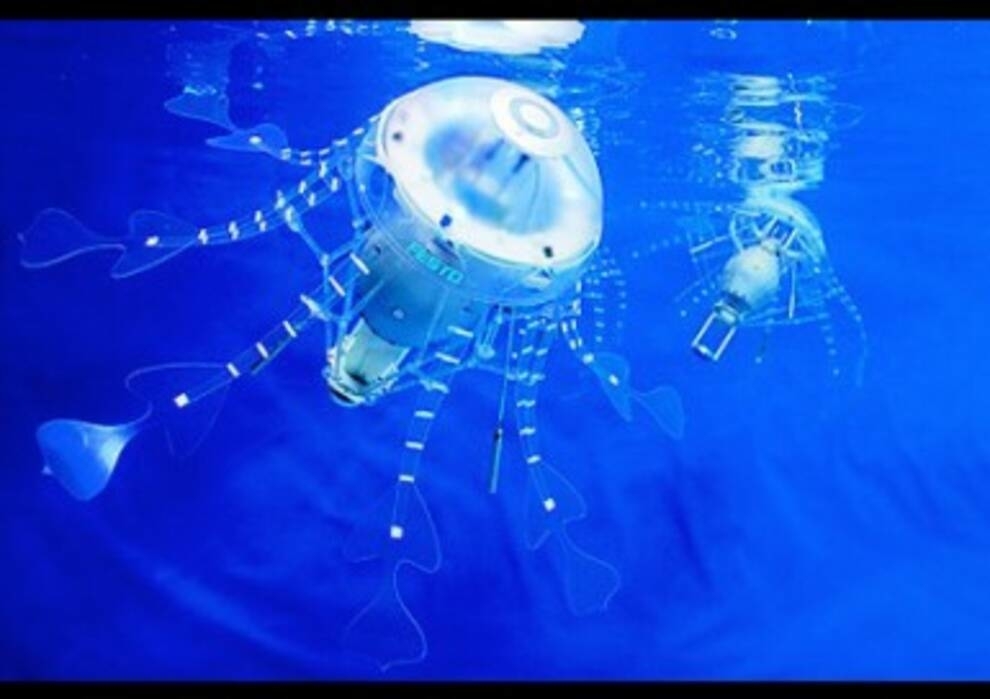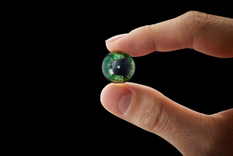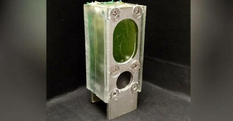
British scientists have developed a jellyfish robot
A team of engineers from the Universities of Edinburgh and Southampton have come up with a robot that moves through the water at a speed previously unattainable.
The prototype of the innovative development was the Aurelia aurita - the moon jellyfish, considered the fastest swimmer in nature. Scientists have equipped the robot with a "moving dome" that mimics the technique of movement of an aquatic creature. The component is made of rubber membrane material. In the upper part of the robot's body, a membrane is attached to a piston with 8 elastic ribs. It should be noted that the edges were printed on a 3D-printer. The piston pushes the "bell", expanding the mechanism to its maximum limits. Immediately after that, the bell takes on its original form, forming powerful jets of water. Thanks to this, the device moves through the water.

This design reproduces the way lunar jellyfish travel. If the bell is struck with the desired frequency, then the robot swims the length of the body in one second. This is due to the vibrations and resonance generated by the force. Thanks to this swimming technique, the jellyfish robot became 10-15 times faster than similar specimens with propellers.
According to study co-author Thierry Boujart, robots of the previous generation, with built-in string systems, sent water through a tube. The new development is distinguished by its elasticity, which makes it possible to simulate resonant vibration. By the way, the engineers involved in the creation of the device understood that the jellyfish robot would be more perfect than its counterparts, but did not expect such high efficiency.
According to scientists, the jellyfish robot will be in demand, and the field of application will be wide. Thanks to its unique shape and plastic material, the robot can easily penetrate places inaccessible to humans and other equipment. For example, it will swim through coral reefs and narrow gorges. Or explores fragile archaeological finds without the risk of damaging them. At the moment, the team is developing applications that are necessary for this kind of devices.
Read also: Australian startup has come up with a way to get moisture from the air
The prototype of the innovative development was the Aurelia aurita - the moon jellyfish, considered the fastest swimmer in nature. Scientists have equipped the robot with a "moving dome" that mimics the technique of movement of an aquatic creature. The component is made of rubber membrane material. In the upper part of the robot's body, a membrane is attached to a piston with 8 elastic ribs. It should be noted that the edges were printed on a 3D-printer. The piston pushes the "bell", expanding the mechanism to its maximum limits. Immediately after that, the bell takes on its original form, forming powerful jets of water. Thanks to this, the device moves through the water.

Photo © popmech.ru
This design reproduces the way lunar jellyfish travel. If the bell is struck with the desired frequency, then the robot swims the length of the body in one second. This is due to the vibrations and resonance generated by the force. Thanks to this swimming technique, the jellyfish robot became 10-15 times faster than similar specimens with propellers.
According to study co-author Thierry Boujart, robots of the previous generation, with built-in string systems, sent water through a tube. The new development is distinguished by its elasticity, which makes it possible to simulate resonant vibration. By the way, the engineers involved in the creation of the device understood that the jellyfish robot would be more perfect than its counterparts, but did not expect such high efficiency.
According to scientists, the jellyfish robot will be in demand, and the field of application will be wide. Thanks to its unique shape and plastic material, the robot can easily penetrate places inaccessible to humans and other equipment. For example, it will swim through coral reefs and narrow gorges. Or explores fragile archaeological finds without the risk of damaging them. At the moment, the team is developing applications that are necessary for this kind of devices.
Read also: Australian startup has come up with a way to get moisture from the air


